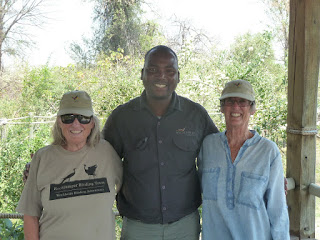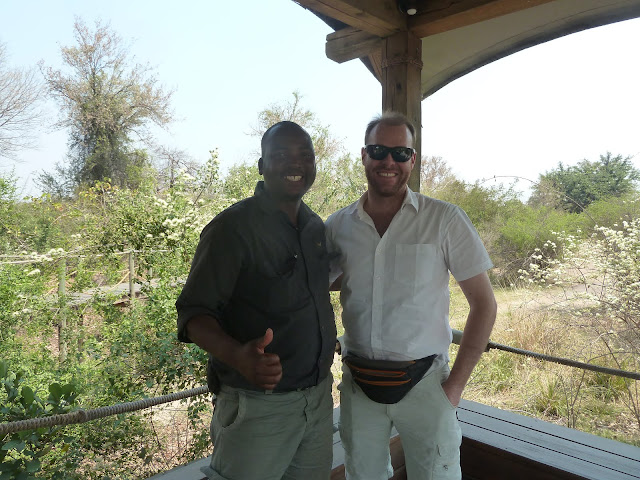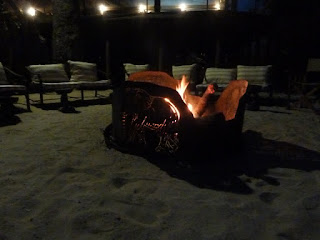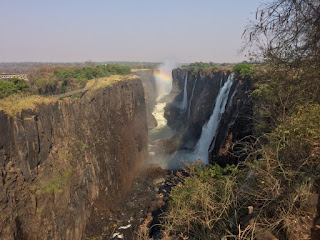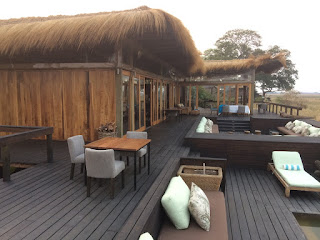WHAT WE'VE LEARNED ABOUT SOUTHERN AFRICA The countries we visited have set aside huge tracts of land for wildlife preservation and protection of habitat. They are to be admired for this. In addition to National Parks, large tracts of land have been leased to private conservationists. In fact, some of these private game parks have more protection for the animals against poachers than the Parks. That is understandable as some of the countries cannot afford the staff to protect against poaching. Glen also told us about the dangers of Malaria. It is a real killer but it is the reason why Africa has one of the lowest population densities of any continent. He worries that if a cure is found for Malaria, Africa's population would explode and these wild areas would disappear with human encroachment. With the habitat gone, there will be no more large herds of different species of antelope, no more elephants, rhinos, leopards, lions, wildebeests, wild dogs, cheetah, Cape bu...
Posts
Showing posts from September, 2018
- Get link
- X
- Other Apps
FAREWELL TO AFRICA I slept very poorly last night as I fretted about the loss of all my photographs from Kalahari Plains onward. Also, I had severe leg cramps that lasted all night, and indigestion which I hope Imodium will alleviate. Despite this, I had a 6:15 wakeup call so that I could join Glen for at 6:30 bird walk around the camp. The first thing we saw was a giant hippo out of the water feeding just outside our tent! The walk was very successful and we added six new birds to the trip list including a Yellow-fronted Tinkerbird that brought out Glen's long-lens camera. We ate breakfast and had a chance to go back to our room for a hour before our ride to the airport left at 10:30. This time we had a 7-passenger, air-conditioned taxi to ourselves. There is no business class lounge so we waited for a time in a restaurant before being asked to leave. There were no seats available so we stood. Our plane was an hour late - no fun. It really shortens our transfer time....
- Get link
- X
- Other Apps
FINAL BOAT CRUISE AND LAST NIGHT AT TOKA LEYA We enjoyed another delightful boat ride down the Zambezi River. We had the pleasure of watching a number of elephants swimming across the river in single file staying very close together their trunks used like snorkelling masks as they blew water out of them. Our main sighting was of a rare melanistic phase African Harrier-Hawk, almost black. Our final dinner of the trip last night was at the pool away from some of the noisier groups that are staying here. Once again, we were among the last groups to leave the table. We have enjoyed each other's company so much, it is going to be hard to say goodbye.
- Get link
- X
- Other Apps
VICTORIA FALLS AND A DISASTER This morning we got to sleep in until 6:15! We were on the road by 7:45, fifteen minutes past our scheduled departure. Since we have a private vehicle, we didn't hold anyone up. This time, we exited the camp without using a boat and drove through the Mosi-oa-Tunya (The Smoke that Thunders) National Park before exiting on the paved highway that leads to Victoria Falls. We were told that there was more water on the Zimbabwe side of the falls but it would have cost an extra $1000 US to go over to view the falls from that side. We opted not to. I was glad we did when I saw that the Zimbabwe side consisted of only three waterfalls while the Zambian side had many more. The water going over the falls was less on the Zambian side but we could see the main waterfall in Zimbabwe. The water level had dropped about six metres in the last few weeks but the Falls were still impressive. We birdied along the gorge and added a couple of species to our lists....
- Get link
- X
- Other Apps
ARRIVAL AT TOKA LEYA CAMP We were met by a private air-conditioned 22-passenger bus at Livingstone Airport for our transfer to Toka Leya - just for us! We were driven to a spot where the bus dropped us off for a boat ride to the camp. It was quite the ride as we went through a section of rapids and managed to get a little wet. That was all right as it was very hot, 37 degrees Celsius, with humidity for the first time on this trip. We were met by the camp staff and offered a refreshing drink and cool facecloth. We had a brief orientation to the camp before being shown to our tent. The first thing we noticed is that it was Air Conditioned! What a relief. The second thing we noticed is that we had separate bedrooms. The tent is very spacious and even has an outdoor tub. We took our time unpacking before lunch. We ordered what we thought was a small pizza with different options for toppings. When it came it was huge. They have a pizza oven here but there was no way I could ...
- Get link
- X
- Other Apps
FLIGHT TO TOKA LEYA We enjoyed a leisurely breakfast and a short bird walk around the camp adding one new species to our lists, before leaving for the airstrip. Our pilot, Josh, was there waiting for us and as quickly as we could, climbed into the plane. We still managed to pick up some Tsetse flies for our journey to Livingstone. The flight is so smooth today that I can actually work on the blog. We will have internet at our next camp, located on the Zambezi River, just a short drive from Livingstone so I hope to update as much as I can. Hope people are still checking in.
- Get link
- X
- Other Apps
OUR LAST NIGHT GAME DRIVE AT SHUMBA We headed out again wondering what wonderful surprises lay in store for us. It wasn't long before Newton had a call on the radio that a cheetah had been spotted. We hurried to the location in time to see a male cheetah with his kill, a female Lechwe. He had dragged it to an island in the plains. These islands are small hillocks that rise above the plains. He was eating it when we arrived, thank heavens it was the hind quarters and so we didn't see the destruction. We did see his face though covered in blood. He soon abandoned his kill and lay down beside it panting. I thought maybe it was because it was still hot but no. Cheetahs expend so much energy chasing down their prey, that they will pant for an hour or more. We also learned that cheetah are the one prey animal that is also preyed upon by lions and leopards. Once a lion or leopard smells the cheetah's kill, they will not only try to steal it, they will attack and kill ...
- Get link
- X
- Other Apps

Sable Antelope herd. At first Newton and Glen thought that maybe this herd was a variety of Sable that were brown rather than black until we spotted the alpha male. The one we saw at Vumbura was black but we only had a fleeting sight as he disappeared into the underbrush. This herd was out in the open. This picture shows the male patrolling his family.
- Get link
- X
- Other Apps
INCREDIBLE, STUNNING, FANTASTIC, UNBELIEVABLE I've run out of superlative words to describe our drive this morning. We both awoke fifteen minutes before our wakeup call at 5:30 and lay in bed talking and giggling. I said: "Let's surprise him, and call out Good Morning, before he says it." This brought on even more giggles. We were on the road by 6:30, this time equipped with two blankets each and three hot water bottles. It is amazing how cold it is first thing in the morning and how quickly the temperature heats up. The one animal that had eluded us was the Hyaena. We didn't see the Brown Hyaena and now were looking for the common Spotted Hyaena to complete the Big Eight (the Big Five - Elephant, Cape Buffalo, Lion, Leopard, and Black Rhino - plus Cheetah, Wild Dog, and Spotted Hyaena). Newton did his 'take off the sunglasses and reach for his binoculars thing', and called out Hyaena. We drove closer. I noticed that the Hyaena was limping. ...
- Get link
- X
- Other Apps
MORE INCREDIBLE SIGHTINGS After suffering through the heat of the day and missing the cooling effects of the kikoi, I made a point of asking the assistant hotel manager if they had any kikoi that we could use to keep cool during the afternoon heat. She looked puzzled until I explained what they were. "Oh, you mean the chitenge. I'll put a couple in the room for you." With that problem solved, we set off with Newton. We had discovered on the morning drive that Newton possesses the eyes of an eagle. He can spot animals at least two kilometres away - even Glen is impressed. We have all learned that when Newton slows down or stops, removes his sunglasses, and checks through his binoculars that we had better pay attention as he has seen something really worthwhile. This happened again not far from camp. He spotted an African Civet - a nocturnal cat-like animal, rarely seen and very secretive. We drove closer and sat silently as the animal approached running al...
- Get link
- X
- Other Apps
SHUMBA CAMP, BUSANGA PLAINS, KAFUE NATIONAL PARK Shumba Camp is situated in the Busanga Plains in the far north of the Kafue National Park. It is one of the largest National Parks in Africa. The Busanga floodplains are vast and we are located in the heart of them. They dry up during the summer (there hasn't been rain here since March) and that is the reason for all of the grass fires. Hippos are sometimes trapped as the pools get more shallow. It is one of the few areas of the world that remain untouched by development and human activity. By the time we got here, I was exhausted. It is a 40-minute drive from the airstrip and we added two new antelope species, the Oribi, and the Puku, and a few new birds to our list including Fulleborn's Longclaw. After a brief orientation we got to our rooms. Glen was given room 4 and we were given room 2. After checking them out, we decided we liked room 4 better as it had a better view. We are the only ones here except for a fam...
- Get link
- X
- Other Apps
WHAT TO EXPECT ON A WILDERNESS SAFARI FLIGHT For the most part we are flying in planes with as few as ten and as many as thirteen seats. Before we left, we had to tell Wilderness Safaris how much we each weighed. We soon found out that, as Norma noted, they should have asked us how wide we were instead. The aisle between the seats - two on the right and one on the left can't be more than a foot across. Plus, you cannot stand up in the plane and have to creep forward. You never want to be seated in the back as the ceiling height is so low you could get a concussion if your flight is at all bumpy. Sometimes we are offered water and earplugs and sometimes not. At the beginning of every flight, you get to stand in the hot sun for a safety briefing - two emergency exits at the front, one at the back. To open the back exit door, pull the lever out and turn it. Same thing for the steps. Only one person on the steps at a time. Fire extinguisher in the front, first-aid kit in t...
